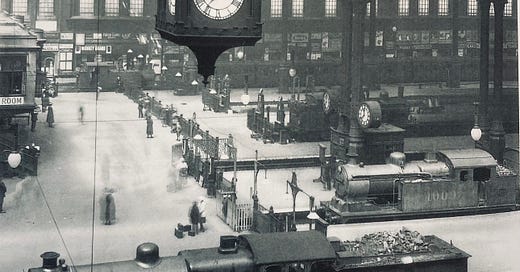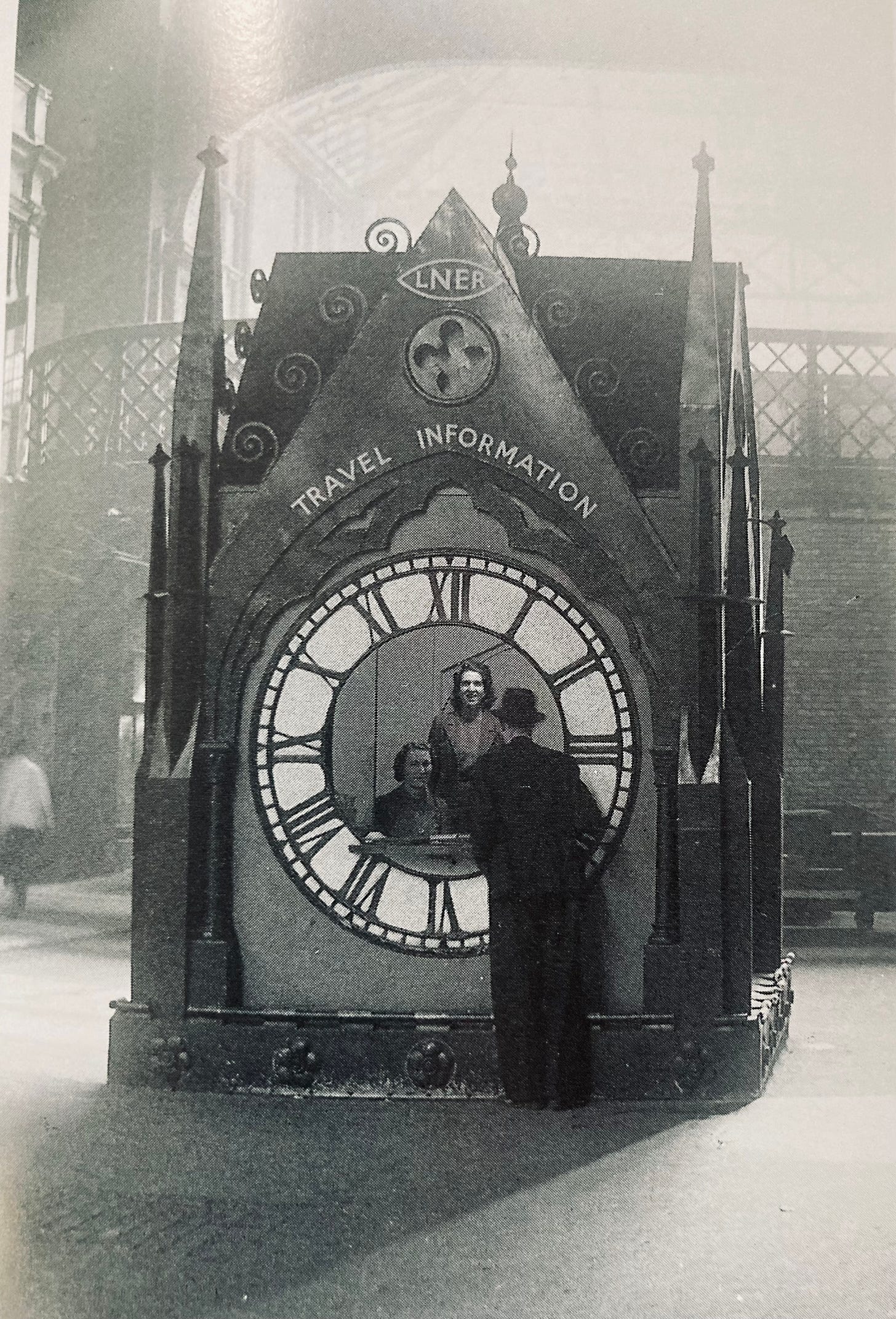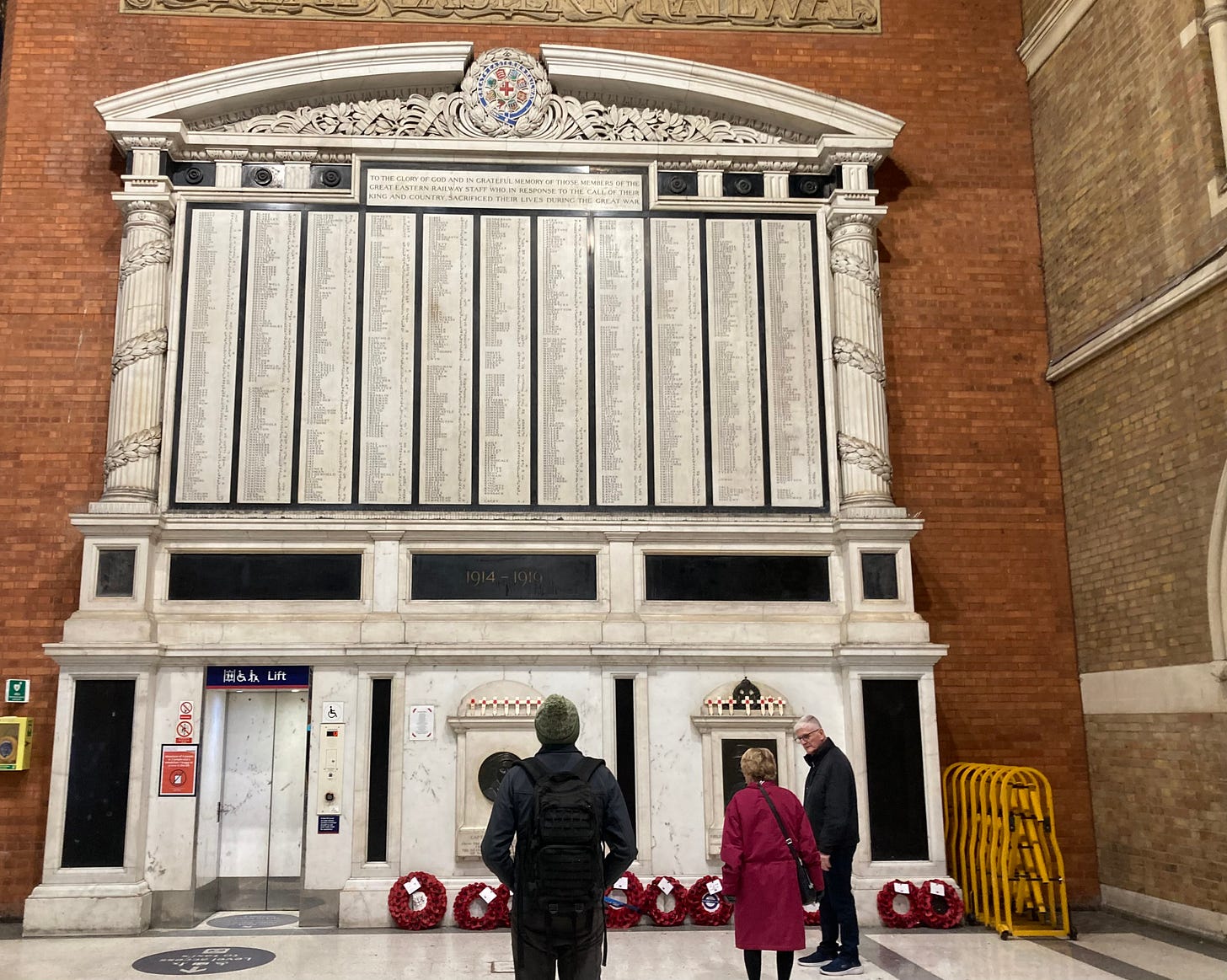When I heard that David Lynch had died, I thought of two things. Firstly, his film Eraserhead, which I saw in a late-night repertory bill in my early twenties. It triggered a feeling that I was only able to label a few years later: horripilation. When I came out of the cinema, every streetlight and parked car seemed placed with sinister intent. Secondly, I thought of Liverpool Street station. Perhaps the most harrowing scene in Lynch’s film, Elephant Man, is when Joseph Merrick alights from a train at Liverpool Street with the white cowl covering his face, only to be chased by a mob over the crude iron footbridge that traversed the platforms when the film was made in 1979, and for a long time before.
Liverpool Street station, opened in 1874, was built on the site of the old Bethlehem Hospital (Bedlam). I don’t think that was a very enlightened institution at the time and the station probably hasn’t done much for that vaunted quality, mental health, either. But it doesn’t deserve to find itself threatened with another redevelopment, of which more below.
Thousands of slum dwellers were evicted to make way for the station. It then became the archetypal commuter terminus, generating suburbs in Essex and east Herts, from which workers blearily rode on the cheap early morning tickets the Great Eastern Railway was required to provide, having created this great treadmill. It was necessary to expand the station in 1894, when another eight platforms and a second trainshed were added to the east of the original tracks, touching Bishopsgate.
The station did have a certain baleful beauty, mainly by virtue of its clusters of tall Corinthian columns, from which the struts of the iron-and-glass trainshed rooves sprouted. John Betjeman described the station as a ‘dark forest’, and presumably it was gloomy even on a summer’s day, being filmed with steam trains until electric traction arrived in 1949. In his well-written and beautifully illustrated book, Great Eastern in Town and Country Volume 2, Chris Hawkins describes Liverpool Street as a place of ‘endless shadows and corners’. Blockhouse-style station offices looked like tombs, while a four-sided gothic clock, resembling a small church, dangled over the platforms, counting down the lives of the commuters. (When this was lowered to the ground in 1941, in case it should crash down in bombing raid, it was hollowed out and used as an enquiry office with the clock face serving as a round window.)
The local trains ran all night. It’s said that a punter, asking a platform guard, ‘When’s the last train to Walthamstow?’ was told, ‘There ain’t no last train to Walthamstow.’ There were also boat train services to Harwich, and trains to the seaside, the Great Eastern, like the GWR, being a ‘holiday line’ once it broke free of London. The posters advertising Cromer, Lowestoft, Southend etc were perhaps hard to make out in the station miasma, and it was to counter smoke and steam that the designers of early holiday posters used broad expanses of bright colour. See, for instance, the beach along which the fat fisherman skips in John Hassall’s poster of 1908: ‘Skegness is SO Bracing’. In 1936, when Hassall was invited to Skegness to receive the freedom of the town, he arrived late, having tried to get there from Liverpool Street, even though King’s Cross was the station for Skegness, which is why the Great Northern Railway had commissioned his poster in the first place.
In Edwardian times, by the way, the Great Eastern delivered barrels of seawater from Lowestoft to Liverpool Street for dispersal around London so that ‘those who have enjoyed the recuperative qualities of sea bathing’ might ‘continue their sea water baths in their own home.’ The casks containing the water were ‘well sealed and fitted with handles for ease of carrying upstairs.’
Until 1986, Liverpool Street stood alongside increasingly dilapidated Broad Street, terminus of the rusty old North London Line, now revived as the wholesome London Overground. In 1984, Paul McCartney’s film, Give My Regards to Broad Street, was released, and I have often wondered why he made it, because it wasn’t very good (except for the music). I knew the producer of the film, Andros Epaminondas, one of the cleverest and most charming men I’ve ever met, and I think even he was a bit bemused by it. Presumably the title was just a play on Give My Regards to Broadway, but was McCartney drawn to the locale by that word ‘Liverpool’, denoting not only the adjacent station, but also modest and attractive little Liverpool Street itself, south of the station, which was named after Lord Liverpool, the Prime Minister?
In 1974, British Rail sought to demolish both stations and replace them with something brand new. Broad Street (what was left of it) was duly knocked down, but Liverpool Street was spared after a campaign in which John Betjeman (fresh from leading the fight for St Pancras) and Spike Milligan were both involved. The station was then sensitively remodelled in the 1980s, insofar as that was possible given that the Broadgate block was built on top of the eastern side of it. So the trainshed of 1894, covering platforms 11-18, made way for a low, oppressive roof. The soaring grandeur of the other trainshed was in some senses enhanced by the restoration of some long-lost decorative features. But the high, conservatory-like tea rooms, projecting from the two sides of the double shed, and bringing a touch of incongruous gentility, were removed.
The architect, Nick Derbyshire, also created a new concourse resembling the original trainshed and running at right angles to the platforms. The two main entrances, on Bishopsgate and Liverpool Street, are marked by twin towers, inspired by a tower of the adjacent (and much messed about with) Great Eastern Hotel. The archway over the carriage shed of the old station was moved and incorporated into the north wall of the hotel, where it abuts the station. Other features of the original station were sprinkled about in and around the concourse, including the Great Eastern Railway War Memorial, which was unveiled at the station on 22 June 1922 by Field Marshall Sir Henry Wilson, who was then shot and killed by the IRA on returning to his home in Eaton Place. A gallery runs around the atrium and here the usual suspects are in residence: M&S Food, Leon etc.
It is Liverpool Street that Martin Amis had in mind when he wrote, in The Information, ‘The railway station had changed since he had last had call to use it. In the meantime its soot-coated, rentboy-haunted vault of tarry girders and toilet glass had become a flowing atrium of boutiques and croissant stalls and limitless cappuccino. Trains no longer dominated it with their train culture of industrial burdens dumbly and filthily borne. Trains now crept in round the back, sorry they were so late, hoping they could still be of use to the proud, strolling, cappuccino-quaffing shoppers of the mall.’
Keep reading with a 7-day free trial
Subscribe to Reading on Trains to keep reading this post and get 7 days of free access to the full post archives.







